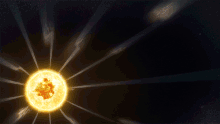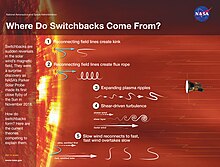
Magnetic switchbacks are sudden reversals in the magnetic field of the solar wind. They can also be described as traveling disturbances in the solar wind that caused the magnetic field to bend back on itself. They were first observed by the NASA-ESA mission Ulysses, the first spacecraft to fly over the Sun's poles. NASA's Parker Solar Probe and NASA/ESA Solar Orbiter both observed switchbacks.
Definition

Magnetic (or solar) switchback is a rapid polarity reversals of the radial heliospheric magnetic field. These events have been termed "switchbacks", when referring to the change in magnetic field direction, or "velocity spikes", when referring to the sharp increase in solar wind speed.
The switchbacks generate heat that warms solar corona.
Observations

Helios 1 and 2 spacecraft observed sudden reversals of the Sun's magnetic field in 1970s. Magnetic switchbacks were then observed by the Ulysses in 1995-1996, during the solar minimum, when the spacecraft detected numerous radial magnetic field polarity inversions. Similar structures were then observed by near-Earth heliospheric spacecraft such as Advanced Composition Explorer. Parker Solar Probe (PSP) observed first switchback on November 6, 2018. Similar effects were observed at distances around and below 0.3 AU, 1 AU, and up to 2.9 AU, and, as noted by Fedorov et al, "the question of whether all such observations relate to the same phenomenon is still open."
On 27 September 2020, ESA/NASA Solar Orbiter (SolO) sampled a solar wind stream magnetically connected to a southern hemisphere coronal hole, while it was at 0.98 AU from Sun, and observed a fast solar wind with strong fluctuations of the magnetic field. The structures observed by SolO may effectively stand as the surviving remains of the switchbacks created near Sun and also observed by PSP.
Given the phase of the solar cycle, if PSP was in the southern magnetic hemisphere, the solar wind magnetic field should always have had a magnetic polarity oriented inward toward the Sun. Instead, PSP observed thousands of intervals, ranging in duration from seconds to tens of minutes where the speed of the solar wind flow suddenly jumps and the magnetic field orientation rotates by nearly 180° in the most extreme cases, before returning just as quickly to the original solar wind conditions.
SolO has found compelling clues as to the origin of magnetic switchbacks during its closest pass by the sun on 25 March 2022. Using the data of the Solar Orbiter Daniele Telloni and Gary Zank and their team came to the conclusion that the theory based on Ulysses data is correct, they "proved that switchbacks occur when there is an interaction between a region of open field lines and a region of closed field lines".
Theories

One theory, based on the Ulysses data, suggests that switchbacks are the result of a clash between open and closed magnetic fields. When an open magnetic field line brushes against a closed magnetic loop, they can reconfigure in a process called interchange reconnection – an explosive rearrangement of the magnetic fields that leads to a switchback shape. The open line snaps onto the closed loop, cutting free a hot burst of plasma from the loop, while "gluing" the two fields into a new configuration. That sudden snap throws an S-shaped kink into the open magnetic field line before the loop reseals. The Parker Solar Probe observed its first switchback on November 6, 2018. The observed switchback was close to the developed model.
A second theory agrees on the import of interchange reconnection, but differs on the nature of switchbacks themselves. Instead of viewing switchbacks as a kink in a magnetic field line, the second theory suggests it is the signature of a kind of magnetic structure, called a flux rope.
Another theory suggests that switchbacks form naturally as the solar wind expands into space.
The switchbacks, essentially S-shaped kinks in the magnetic field lines streaming from the Sun, seem to arise from a reconfiguration of open and looped magnetic field lines already in the Sun's atmosphere. When an open magnetic field line encounters a closed magnetic loop they can undergo a process called interchange reconnection. This allows the open magnetic field line to snap into the loop, and allows one side of the formerly closed magnetic loop to connect to solar magnetic field extending outwards into the solar system. This process would create an outward-flowing S-shaped kink in the newly formed open magnetic field line — a shape that tracks with the switchbacks measured by Parker Solar Probe.
Gallery
-
 Illustration of Parker Solar Probe flying through a switchback in the solar wind.
Illustration of Parker Solar Probe flying through a switchback in the solar wind.
-
 Illustration of global magnetic field circulation enabled by interchange reconnection. In this scenario an open magnetic field line is (A) dragged against a large coronal loop, by global circulation in the corona, (B) undergoes interchange reconnection, and (C) effectively jumps the approximate width of the originally closed loop, launching an S-shaped switchback in the magnetic field into the corona.
Illustration of global magnetic field circulation enabled by interchange reconnection. In this scenario an open magnetic field line is (A) dragged against a large coronal loop, by global circulation in the corona, (B) undergoes interchange reconnection, and (C) effectively jumps the approximate width of the originally closed loop, launching an S-shaped switchback in the magnetic field into the corona.
-
 Close to the Sun, and especially above active regions, there are open and closed magnetic field lines. The closed lines are loops of magnetism that arch up into the solar atmosphere before curving round and disappearing back into the Sun.
Close to the Sun, and especially above active regions, there are open and closed magnetic field lines. The closed lines are loops of magnetism that arch up into the solar atmosphere before curving round and disappearing back into the Sun.
See also
Further reading
- Schwadron, N. A.; McComas, D. J. (2021). "Switchbacks Explained: Super-Parker Fields—The Other Side of the Sub-Parker Spiral". The Astrophysical Journal. 909 (1): 95. arXiv:2102.03696. Bibcode:2021ApJ...909...95S. doi:10.3847/1538-4357/abd4e6. S2CID 231846671.
- Bale, S. D.; et al. (June 2023). "Interchange reconnection as the source of the fast solar wind within coronal holes". Nature. 618 (7964): 252–256. arXiv:2208.07932. Bibcode:2023Natur.618..252B. doi:10.1038/s41586-023-05955-3. ISSN 1476-4687. PMC 10247371. PMID 37286648. S2CID 254247367.
References
- ^
 This article incorporates text from this source, which is in the public domain: Hatfield, Miles (29 April 2020). "New Insight Into Parker Solar Probe's Early Observations". NASA.
This article incorporates text from this source, which is in the public domain: Hatfield, Miles (29 April 2020). "New Insight Into Parker Solar Probe's Early Observations". NASA.
- ^
 This article incorporates text from this source, which is in the public domain: Hatfield, Miles (8 March 2021). "Switchbacks Science: Explaining Parker Solar Probe's Magnetic Puzzle". NASA. Retrieved 31 July 2022.
This article incorporates text from this source, which is in the public domain: Hatfield, Miles (8 March 2021). "Switchbacks Science: Explaining Parker Solar Probe's Magnetic Puzzle". NASA. Retrieved 31 July 2022.
- ^ Fisk, L. A.; Kasper, J. C. (1 May 2020). "Global Circulation of the Open Magnetic Flux of the Sun". The Astrophysical Journal Letters. 894 (1): L4. Bibcode:2020ApJ...894L...4F. doi:10.3847/2041-8213/ab8acd. S2CID 218640684.
 Material was copied from this source, which is available under a Creative Commons Attribution 3.0
Material was copied from this source, which is available under a Creative Commons Attribution 3.0
- ^ Fedorov, A.; et al. (1 December 2021). "Switchback-like structures observed by Solar Orbiter". Astronomy & Astrophysics. 656: A40. Bibcode:2021A&A...656A..40F. doi:10.1051/0004-6361/202141246. ISSN 0004-6361. Retrieved 23 May 2023.
 Material was copied from this source, which is available under a Creative Commons Attribution 4.0
Material was copied from this source, which is available under a Creative Commons Attribution 4.0
- Zurbuchen, Thomas. "How a NASA Probe Solved a Scorching Solar Mystery". Quanta Magazine. Retrieved 11 May 2024.
- ^ "Solar Orbiter solves magnetic switchback mystery". www.esa.int. Retrieved 2022-09-19.
- Telloni, Daniele; et al. (2022). "Observation of a Magnetic Switchback in the Solar Corona". The Astrophysical Journal Letters. 936 (936:L25): L25. arXiv:2206.03090. Bibcode:2022ApJ...936L..25T. doi:10.3847/2041-8213/ac8104. hdl:2158/1282780. S2CID 249431657.
- Zank, G. P.; Nakanotani, M.; Zhao, L.-L.; Adhikari, L.; Kasper, J. (1 November 2020). "The Origin of Switchbacks in the Solar Corona: Linear Theory". The Astrophysical Journal. 903 (1): 1. Bibcode:2020ApJ...903....1Z. doi:10.3847/1538-4357/abb828. S2CID 229001633.
- Drake, J. F.; Agapitov, O.; Swisdak, M.; Badman, S. T.; Bale, S. D.; Horbury, T. S.; Kasper, J. C.; MacDowall, R. J.; Mozer, F. S.; Phan, T. D.; Pulupa, M.; Szabo, A.; Velli, M. (June 2021). "Switchbacks as signatures of magnetic flux ropes generated by interchange reconnection in the corona". Astronomy & Astrophysics. 650: A2. arXiv:2009.05645. Bibcode:2021A&A...650A...2D. doi:10.1051/0004-6361/202039432. S2CID 221655769.
- Squire, J.; Chandran, B. D. G.; Meyrand, R. (2020). "In-situ Switchback Formation in the Expanding Solar Wind". The Astrophysical Journal. 891 (1): L2. arXiv:2001.08422. Bibcode:2020ApJ...891L...2S. doi:10.3847/2041-8213/ab74e1. S2CID 210860810.